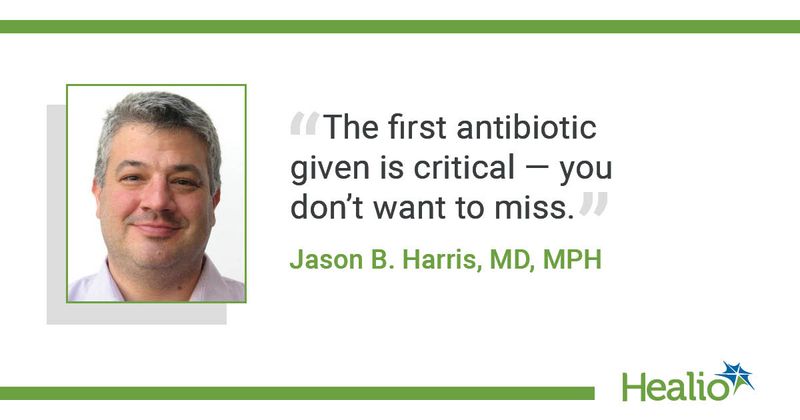Infection
‘Incorrect’ initial antibiotic treatment for K . pneumonia increases patient mortality
September 13, 2023
3 min read
Source/Disclosures
Published by:
Disclosures:
Harris reports no relevant financial disclosures. Please see the study for all other authors’ relevant financial disclosures.
Key takeaways:
- Intra-abdominal infection was the most common source of Klebsiella pneumoniae infection.
- Patients treated with “incorrect” first antibiotics for K. pneumonia were more than 5 times as likely to die.
After assessing Klebsiella pneumoniae bloodstream infections, researchers are calling for more rapid identification methods to find patients with resistant infections because choosing the wrong first antibiotics increases mortality risk.
“We had a few goals in mind when we did this study. Foremost, we wanted to know who is most at risk for dying from invasive Klebsiella pneumoniae infection and why? It’s essential to answer this question to prevent deaths caused by K. pneumoniae,” Jason B. Harris, MD, MPH, FAAP, FIDSA, division chief of Pediatric Global Health and professor of pediatrics at Harvard Medical School, told Healio.
“We also wanted to know what proportion of the cases were caused by closely genetically linked bacteria. If bacteria are closely related genetically, that suggests they may also be epidemiologically linked and have the same source of infection,” Harris said.
To answer these questions, Harris and colleagues identified 562 patients at Massachusetts General Hospital with K. pneumoniae bloodstream infection (BSI) between 2016 and 2022. The researchers collected and assessed data on comorbidities, infection source, clinical outcomes and antibiotic resistance, and then performed whole-genome sequencing on 108 sequential BSI isolates from 2021 to 2022.
Overall, they found that intra-abdominal infection was the most common source of infection, accounting for 34% of all BSIs. They also determined that a respiratory source accounted for only 6% of BSIs. However, these infections were associated with a higher in-hospital mortality rate (adjusted OR = 5.4; 95% CI, 2.2-12.8) compared with infections from other sources.
Harris added that study findings also showed that patients with K. pneumoniae bacteremia who were given the “incorrect” first antibiotic, specifically one to which the bacteria was resistant, were more than 5 times as likely to die as patients who were treated with a “correct” antibiotic (aOR = 5.2; 95% CI, 2.2-12.4).
“This shows that there are life-or-death consequences to choosing the right first antibiotic,” Harris said. “More concerning was that in many cases where an ‘incorrect’ antibiotic was given, there were no obvious clues from past cultures that the patient was going to have a highly resistant bacterial infection.”
Based on these results, Harris said that giving the right first antibiotic is essential, but better tools are needed to identify those who are at risk of having a resistant infection.
“In our cohort, 7% of patients got a first antibiotic to which the bacteria was resistant,” he said. “This number could be lowered by giving more powerful or broad-spectrum antibiotics up front, but if we did that, we’d also be giving more people these antibiotics who don’t need them, further fueling antibiotic resistance.”
Because of this, he said that the best approach would be using more and better rapid diagnostics and preventing these infections in the first place.
Additional data collected during the study showed that BSI isolates were genetically diverse, and no clusters of epidemiologically and genetically linked cases were observed.
Harris explained that this is not because Klebsiella is not transmitted in the hospital, but because most of the spread in the hospital goes unnoticed because only a small percent of those infected will go on to develop invasive disease.
“When you have a patient with K. pneumoniae bacteremia, especially with a respiratory source of infection, you are looking at a very high-risk scenario for them. The first antibiotic given is critical — you don’t want to miss. Yet the overuse of potent antibiotics poses a risk of contributing to antibiotic resistance,” Harris said. “As clinicians, we need to understand this problem and we need to carefully assess our patients to make our best individual choice while recognizing our limited ability to predict who harbors more resistant bacteria.”
He added, “most of all we need to embrace new models and diagnostic tools to identify those who are at risk of or harbor resistant infections.”

